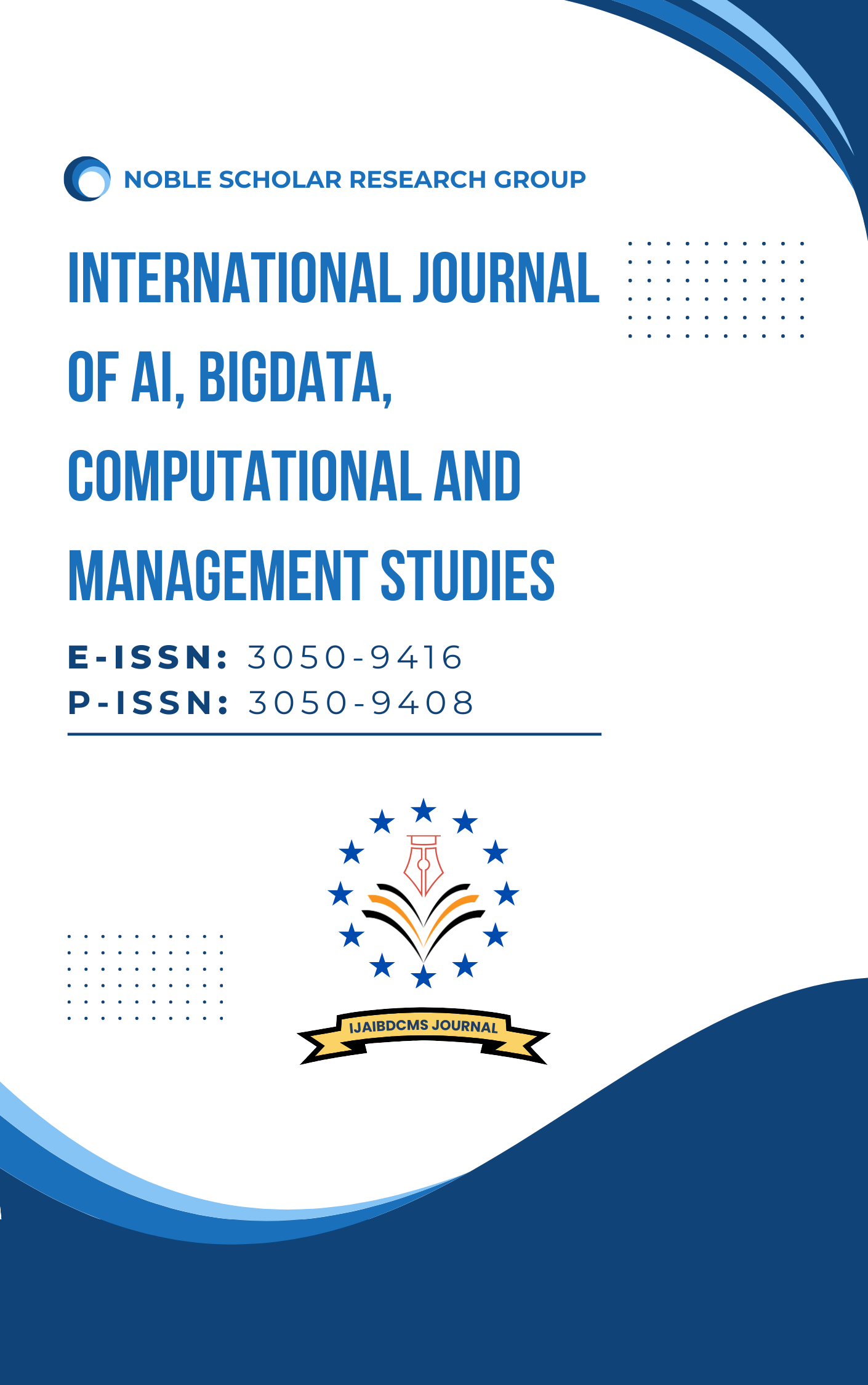An AI-Driven Architecture for End-to-End Network Slicing in Multi-Operator 5G Networks
DOI:
https://doi.org/10.63282/3050-9416.IJAIBDCMS-V4I1P112Keywords:
5G Networks, Network Slicing, Multi-Operator, Artificial Intelligence, Deep Reinforcement Learning, Software-Defined Networking, Federated Learning, QoSAbstract
Network slicing is a transformative concept in 5G networks that enables the provisioning of multiple virtual networks on a shared physical infrastructure. This paper proposes an Artificial Intelligence (AI)-driven architecture for End-To-End (E2E) network slicing across multi-operator 5G networks. Traditional approaches to network slicing face scalability, resource optimization, and inter-operator coordination challenges. This paper presents an innovative framework that integrates AI technologies, including Deep Reinforcement Learning (DRL), Federated Learning (FL), and Software-Defined Networking (SDN), to dynamically orchestrate network slices. The proposed solution ensures slice isolation, end-to-end Quality Of Service (QoS), and resource utilization optimization, leveraging a hybrid control plane that facilitates both centralized intelligence and distributed autonomy. The AI agents are trained on heterogeneous datasets derived from multiple operators, enabling predictive analytics for traffic forecasting, anomaly detection, and adaptive resource allocation. A detailed comparative analysis with existing architectures shows the proposed model significantly improves latency, throughput, and energy efficiency. Evaluation metrics include slice creation time, resource efficiency, and inter-operator handoff success rates. Real-time emulations using network simulators and test beds validate the efficacy of the architecture. This paper also discusses key security, interoperability, and standardization challenges, proposing solutions to address them in multi-domain environments. Finally, we examine future research directions and open issues for AI-based orchestration in 6G and beyond. The proposed AI-driven network slicing architecture offers a scalable, flexible, and efficient solution for next-generation multi-operator 5G ecosystems
References
1. Banchs, A., Breitbach, M., Costa, X., Doetsch, U., Redana, S., Sartori, C., & Schotten, H. (2015, May). A Novel Radio Multiservice adaptive network Architecture for 5G networks. In 2015 IEEE 81st Vehicular Technology Conference (VTC Spring) (pp. 1-5). IEEE.
2. Richart, M., Baliosian, J., Serrat, J., & Gorricho, J. L. (2016). Resource slicing in virtual wireless networks: A survey. IEEE Transactions on Network and Service Management, 13(3), 462-476.
3. Zhang, C., Patras, P., & Haddadi, H. (2019). Deep learning in mobile and wireless networking: A survey. IEEE Communications surveys & tutorials, 21(3), 2224-2287.
4. Ksentini, A., & Nikaein, N. (2017). Toward enforcing network slicing on RAN: Flexibility and resources abstraction. IEEE Communications Magazine, 55(6), 102-108.
5. Liang, L., Ye, H., & Li, G. Y. (2019). Spectrum sharing in vehicular networks based on multi-agent reinforcement learning. IEEE Journal on Selected Areas in Communications, 37(10), 2282-2292.
6. Xiong, Z., Zhang, Y., Niyato, D., Deng, R., Wang, P., & Wang, L. C. (2019). Deep reinforcement learning for mobile 5G and beyond: Fundamentals, applications, and challenges. IEEE Vehicular Technology Magazine, 14(2), 44-52.
7. Alliance, N. G. M. N. (2015). 5G white paper. Next generation mobile networks, white paper, 1(2015).
8. Yousaf, F. Z., Bredel, M., Schaller, S., & Schneider, F. (2017). NFV and SDNKey technology enablers for 5G networks. IEEE Journal on Selected Areas in Communications, 35(11), 2468-2478.
9. Benzaid, C., & Taleb, T. (2020). AI-driven zero-touch network and service management in 5G and beyond: Challenges and research directions. IEEE Network, 34(2), 186-194.
10. Caballero, P., Banchs, A., De Veciana, G., & Costa-Pérez, X. (2019). Network slicing games: Enabling customization in multi-tenant mobile networks. IEEE/ACM Transactions on Networking, 27(2), 662-675.
11. Carrozzo, G., Siddiqui, M. S., Betzler, A., Bonnet, J., Perez, G. M., Ramos, A., & Subramanya, T. (2020, June). AI-driven zero-touch operations, security and trust in multi-operator 5G networks: A conceptual architecture. In 2020, European Conference on Networks and Communications (EuCNC) (pp. 254-258). IEEE.
12. Tsourdinis, T., Chatzistefanidis, I., Makris, N., & Korakis, T. (2022, May). AI-driven service-aware real-time slicing for beyond 5G networks. In IEEE INFOCOM 2022-IEEE Conference on Computer Communications Workshops (INFOCOM WKSHPS) (pp. 1-6). IEEE.
13. Ali, H. (2022). Reinforcement learning in healthcare: optimizing treatment strategies, dynamic resource allocation, and adaptive clinical decision-making. Int. J. Comput. Appl. Technol. Res., 11(3), 88-104.
14. Vengerov, D. (2007). A reinforcement learning approach to dynamic resource allocation. Engineering Applications of Artificial Intelligence, 20(3), 383-390.
15. Chowdhury, A., Raut, S. A., & Narman, H. S. (2019). DA-DRLS: Drift adaptive deep reinforcement learning based scheduling for IoT resource management. Journal of Network and Computer Applications, 138, 51-65.
16. Qian, B., Zhou, H., Ma, T., Yu, K., Yu, Q., & Shen, X. (2020). Multi-operator spectrum sharing for massive IoT coexisting in 5G/B5G wireless networks. IEEE Journal on Selected Areas in Communications, 39(3), 881-895.
17. Zhang, S. (2019). An overview of network slicing for 5G. IEEE Wireless Communications, 26(3), 111-117.
18. Subedi, P., Alsadoon, A., Prasad, P. W. C., Rehman, S., Giweli, N., Imran, M., & Arif, S. (2021). Network slicing: A next-generation 5G perspective. EURASIP Journal on Wireless Communications and Networking, 2021(1), 102.
19. Arsénio, A., Serra, H., Francisco, R., Nabais, F., Andrade, J., & Serrano, E. (2013). Internet of intelligent things: Bringing artificial intelligence into things and communication networks. In Inter-cooperative collective intelligence: Techniques and applications (pp. 1-37). Berlin, Heidelberg: Springer Berlin Heidelberg.
20. Bai, Z. (2022, February). Research on the Application of Artificial Intelligence in Communication Networks. In Journal of Physics: Conference Series (Vol. 2209, No. 1, p. 012014). IOP Publishing.
21. Aragani, Venu Madhav and Maroju, Praveen Kumar and Mudunuri, Lakshmi Narasimha Raju, “Efficient Distributed Training through Gradient Compression with Sparsification and Quantization Techniques” (September 29, 2021). Available at SSRN: https://ssrn.com/abstract=5022841 or http://dx.doi.org/10.2139/ssrn.5022841



